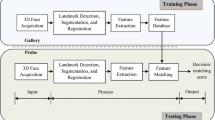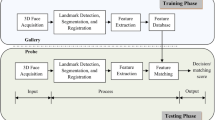Abstract
Most face recognition systems employ 2-D color or gray-scale images. However, face recognition based on 2-D images is adversely affected by 3-D movement, variable lighting, and the use of cosmetics. 3-D image measurement technology has the potential to overcome these limitations of face recognition based on 2-D images since it can perform geometric analysis. We propose a method that is capable of recognizing a person from a 3-D facial image obtained using a 3-D shape measurement system by employing a technique that optimizes the intensity-modulation pattern projection. This face recognition method is based on the iterative closest point algorithm. It is robust to changes in reflectivity and color. Since the 3-D facial information can be registered, this method can estimate rotations and translations to compensate for different positions or directions. In order to prove the validity of the proposed technique, a verification experiment was conducted which used 105 sample 3-D images obtained from 15 subjects. It achieved a detection rate of 96% when heads were turned at an angle of 20° or less relative to the camera.
Similar content being viewed by others
References
Turk M, Pentland A (1991) Eigenfaces for recognition. J Cognitive Neurosci 3(1):71–86
Belhumur P, Hespnha J, Kriegman D (1997) Eigenfaces vs. fisherfaces: recognition using class-specific linear projection. IEEE Trans Pattern Anal Mach Intell 19:711–720
Sakano H (2001) Principal component analysis in pattern recognition: from the viewpoint of facial image recognition. Proc Inst Stat Math 49(1):23–42
Lu C (2003) Optimal intensity-modulation projection technique for three-dimensional shape measurement. Appl Optics-IP, pp 4649–4657
Besl PJ (1992) A method for registration of 3-D shapes. IEEE Trans Pattern Anal Mach Intell 14(2):239–256
Berg M, Kreveld M, Overmars M, et al (2008) Computational geometry: algorithms and applications. Springer, New York
Horn BKP (1987) Closed-form solution of absolute orientation using unit quaternions. J Opt Soc Am, pp 629–642
Author information
Authors and Affiliations
Corresponding author
About this article
Cite this article
Kamitomo, H., Lu, C. 3-D face recognition method based on optimum 3-D image measurement technology. Artif Life Robotics 16, 551–554 (2012). https://doi.org/10.1007/s10015-011-0982-0
Received:
Accepted:
Published:
Issue Date:
DOI: https://doi.org/10.1007/s10015-011-0982-0




